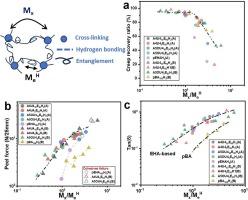Influence of hydrogen bonding interactions, entanglement, and covalent crosslinking on the viscoelasticity of acrylic viscoelastomers containing urea group
IF 5.8
2区 化学
Q1 POLYMER SCIENCE
引用次数: 0
Abstract
The structure–property relationship of acrylic clear viscoelastomer films (acrylic CVFs) as foldable optical clear adhesives (OCAs) has always been unclear. In our work, a series of acrylic CVFs with different hydrogen-bonding interactions (H-bondings) and cross-linking densities (namely, CL-H-copolymers) were synthesized. The effects of entanglement, H-bonding, and covalent crosslinking on the recovery and adhesive properties of CL-H copolymers were analyzed by rheology, equilibrium swelling, and tensile stress–strain tests (tensile tests). The structural parameter Mx/MeH was obtained by combining the affine deformation model, the Flory-Rehner equation, and the UCM-Gent model, where Mx is the molecular weight between covalent crosslinkers and MeH is the a physical crosslinking molecular weight affected by H-bondings. The experimental results showed that the CL-H-copolymers had an obvious dependence on Mx/MeH. Recovery properties tended to stabilize (>90 %) at Mx/MeH < 1, while adhesion strengths continued to decrease with decreasing Mx/MeH. This conclusion and methodology are instructive for the design of foldable OCAs with high elasticity and high adhesion performance.

氢键相互作用、缠结和共价交联对含尿素基团的丙烯酸粘弹性的影响
丙烯酸透明粘弹性薄膜(丙烯酸 CVF)作为可折叠光学透明粘合剂(OCA)的结构-性能关系一直不明确。在我们的工作中,合成了一系列具有不同氢键相互作用(H-键)和交联密度的丙烯酸透明粘弹性薄膜(即 CL-H-共聚物)。通过流变学、平衡溶胀和拉伸应力应变试验(拉伸试验)分析了缠结、氢键和共价交联对 CL-H 共聚物的恢复和粘合性能的影响。结构参数 Mx/MeH 是结合仿射变形模型、Flory-Rehner 方程和 UCM-Gent 模型得到的,其中 Mx 是共价交联剂之间的分子量,MeH 是受 H 键影响的物理交联分子量。实验结果表明,CL-H-共聚物与 Mx/MeH 有明显的依赖关系。当 Mx/MeH 为 1 时,恢复性能趋于稳定(90%),而粘附强度则随着 Mx/MeH 的降低而降低。这一结论和方法对设计具有高弹性和高粘附性能的可折叠 OCA 具有指导意义。
本文章由计算机程序翻译,如有差异,请以英文原文为准。
求助全文
约1分钟内获得全文
求助全文
来源期刊

European Polymer Journal
化学-高分子科学
CiteScore
9.90
自引率
10.00%
发文量
691
审稿时长
23 days
期刊介绍:
European Polymer Journal is dedicated to publishing work on fundamental and applied polymer chemistry and macromolecular materials. The journal covers all aspects of polymer synthesis, including polymerization mechanisms and chemical functional transformations, with a focus on novel polymers and the relationships between molecular structure and polymer properties. In addition, we welcome submissions on bio-based or renewable polymers, stimuli-responsive systems and polymer bio-hybrids. European Polymer Journal also publishes research on the biomedical application of polymers, including drug delivery and regenerative medicine. The main scope is covered but not limited to the following core research areas:
Polymer synthesis and functionalization
• Novel synthetic routes for polymerization, functional modification, controlled/living polymerization and precision polymers.
Stimuli-responsive polymers
• Including shape memory and self-healing polymers.
Supramolecular polymers and self-assembly
• Molecular recognition and higher order polymer structures.
Renewable and sustainable polymers
• Bio-based, biodegradable and anti-microbial polymers and polymeric bio-nanocomposites.
Polymers at interfaces and surfaces
• Chemistry and engineering of surfaces with biological relevance, including patterning, antifouling polymers and polymers for membrane applications.
Biomedical applications and nanomedicine
• Polymers for regenerative medicine, drug delivery molecular release and gene therapy
The scope of European Polymer Journal no longer includes Polymer Physics.
 求助内容:
求助内容: 应助结果提醒方式:
应助结果提醒方式:


